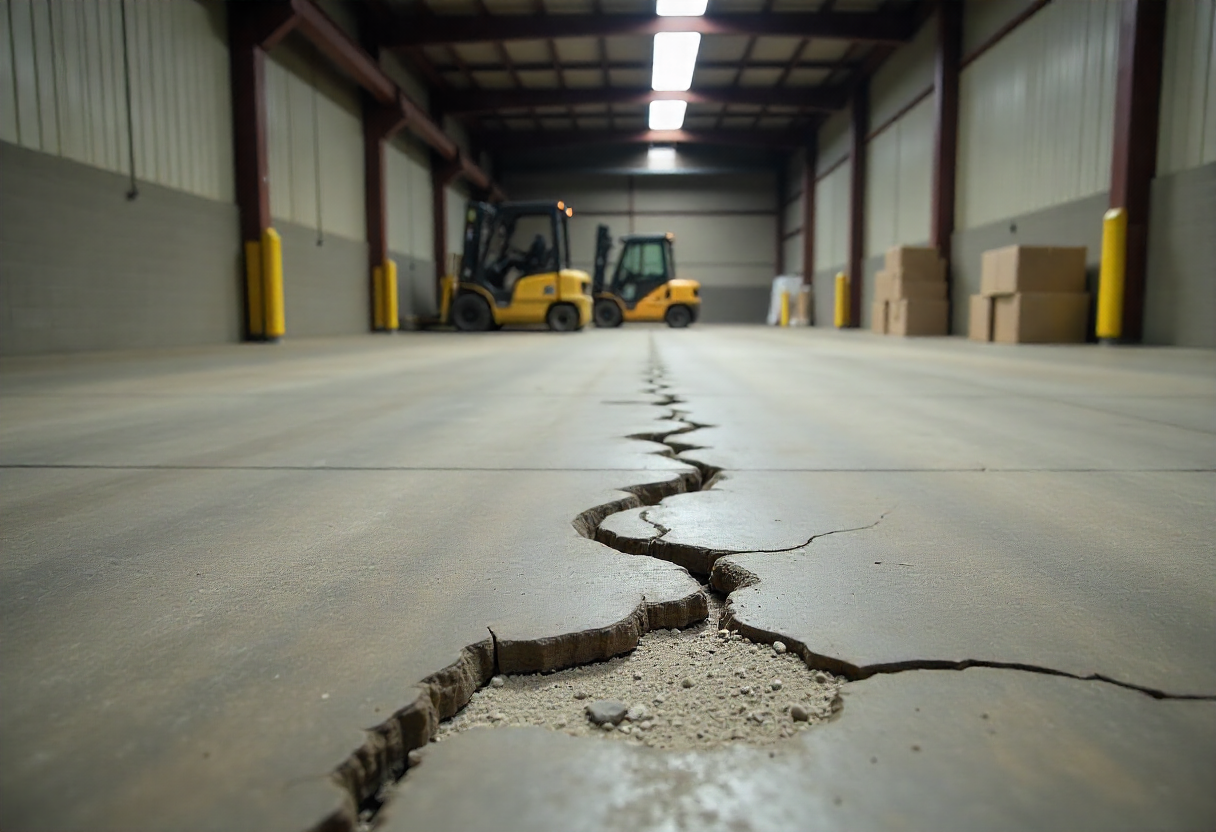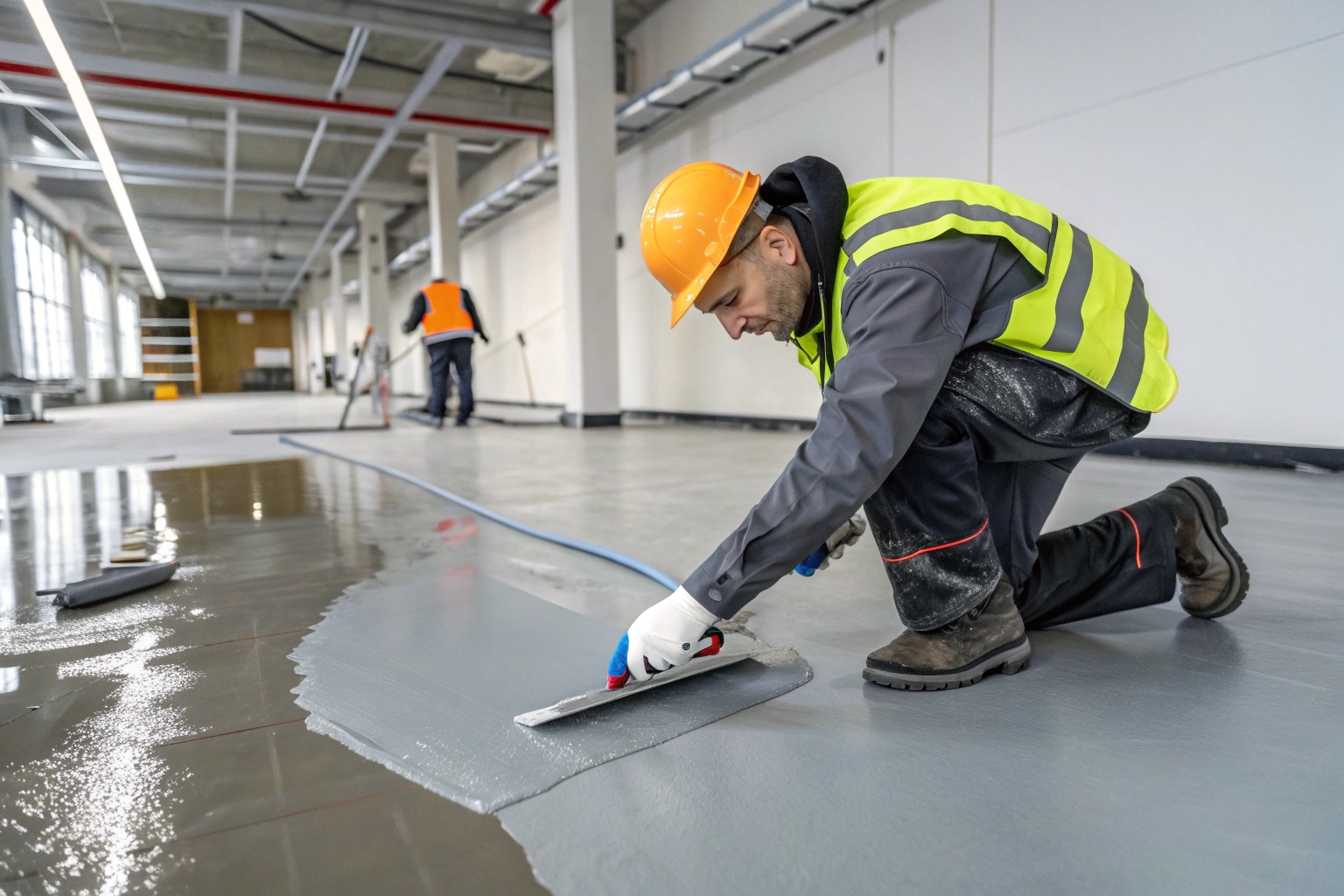Why Warehouse Floors Fail in Wollongong's Industrial Environment

The concrete dust is where things get expensive in ways most operators don’t connect to their floors. That fine powder doesn’t just coat your inventory – it gets into equipment bearings, clogs filters, settles on products waiting to ship. I’ve seen operations spending thousands on air filtration systems when their real problem was unsealed concrete generating dust with every forklift pass.
Every warehouse manager’s tried the patch-and-pray approach. Fill the cracks, smooth over the rough spots, get back to work. But patches fail because they’re fighting physics. The same forces that destroyed your original concrete will destroy the patch, usually faster because patch material rarely bonds properly to damaged concrete. You’re not fixing the problem – you’re just postponing the day you admit you need a real solution.

How Heavy-Duty Warehouse Epoxy Flooring Actually Works
Warehouse Applications Across Wollongong's Logistics Sector
Port Kembla Distribution Centers
High-traffic import/export and freight facilities near Port Kembla rely on heavy-duty epoxy flooring to prevent disruptions and withstand constant container movement—unlike concrete, it requires minimal maintenance.
Industrial Estate Storage Facilities
From manufacturing storage to logistics hubs, Wollongong’s industrial estates demand flooring that adapts to varied loads, traffic, and layouts. Epoxy offers durability, versatility, and consistent performance across all zones.
Cold Storage & Temperature-Controlled Environments
In cold storage, epoxy flooring resists thermal shock, moisture, and cracking—conditions that destroy standard concrete. It maintains integrity and protection even under extreme temperature cycles.
Manufacturing & Production Storage
Manufacturing warehouses face chemical exposure, heavy forklift use, and cleanliness requirements. Epoxy provides durable, seamless, and easy-to-clean surfaces that support safe and efficient production.
E-Commerce Fulfillment Centers
With constant movement and rapid turnover, fulfillment centers need smooth, resilient, low-maintenance floors. Epoxy keeps up with high-speed operations and minimizes downtime.
Automotive & Parts Distribution
For automotive warehouses, epoxy flooring prevents concrete dust contamination, supports heavy loads, and improves safety with non-slip textures and marked pathways.
Perfect Applications for Every Type of Wollongong Property

Long-Term Epoxy Flooring Performance and Maintenance
Proper maintenance is the key to ensuring your epoxy flooring delivers decades of reliable performance. Regular cleaning, scheduled inspections, and early attention to high-traffic wear zones prevent small issues from turning into major repairs. By tailoring maintenance routines to your facility’s specific use—whether a light-duty storage area or a high-traffic distribution hub—you can keep operations running smoothly and your floors looking as good as new. Rapid repair protocols also mean any accidental damage can be addressed quickly without costly downtime.
Wollongong’s changing seasons bring challenges like moisture in winter and heat in summer, but epoxy’s resilience—combined with seasonal upkeep—keeps it performing year-round. Through consistent monitoring, documentation, and proactive care, you not only extend your floor’s lifespan but also maximize your return on investment. Most facilities find epoxy pays for itself within a few years through reduced maintenance costs, improved durability, and long-term operational savings.

Economic Impact on Warehouse Operations
Epoxy flooring delivers measurable economic benefits for warehouse operations by improving efficiency, safety, and long-term value. Smooth, durable surfaces enhance material movement, reduce equipment wear, and improve lighting reflection—boosting productivity without increasing labor or machinery. Safer floors also mean fewer accidents, lower insurance claims, and potential premium reductions. At the same time, quality flooring enhances property value, signaling to buyers and tenants that the facility is well maintained and ready for immediate use.
Beyond daily operations, epoxy flooring protects your concrete slab from costly damage and full replacements that could shut down operations for weeks. It also strengthens your competitive position by supporting faster, cleaner, and safer workflows—key advantages in the logistics sector. As your business grows, epoxy systems can be extended and seamlessly integrated, ensuring your investment continues to support scalability and long-term operational success.

Technology Integration and Future-Proofing
Getting Started With Your Warehouse Flooring Project
Getting started with your warehouse flooring project begins with a thorough site evaluation to assess your facility’s condition, operational needs, and any required concrete repairs. From there, we develop a custom flooring specification tailored to your actual traffic, equipment, and environmental factors—ensuring durability and performance. We then coordinate installation around your business operations to minimize disruption and provide clear cost and timeline estimates upfront. Throughout the process, we maintain strict quality assurance and offer warranty coverage for lasting protection. After installation, we provide maintenance training and ongoing support to keep your floor performing at its best.
FAQs About Warehouse Epoxy Flooring
What should you not put on an epoxy floor?
Don’t drag sharp metal objects across the surface or use abrasive cleaning pads that’ll scratch the finish. Heavy machinery with poorly maintained wheels can gouge the coating, so keep your forklifts serviced. Avoid petroleum-based cleaners or solvents unless your specific system’s rated for them – most warehouse epoxies handle spills fine, but harsh chemicals in concentrated form sitting for hours can soften some formulations. In Wollongong’s coastal environment, I also tell operators to keep saltwater and de-icing chemicals off the floor since they can break down the bond over time.
How thick should epoxy flooring be?
Industrial warehouse floors typically need 10-20 mils thickness for standard traffic areas, but high-wear zones like turning lanes and loading docks often get 30-40 mils or more. The thickness depends on your specific operation – a light storage facility needs less protection than a distribution center running forklifts 24/7. We measure your traffic patterns and equipment weights to spec the right build, because too thin fails early and too thick wastes money without adding real performance. Most Wollongong warehouse installations I oversee run 15-25 mils as a sweet spot for durability and cost.
What is the difference between epoxy and resin?
Epoxy is actually a type of resin – specifically a thermosetting resin that hardens through a chemical reaction when you mix two components together. Other resins like polyurethane or polyaspartic cure differently and have different properties, but “epoxy resin” and “epoxy coating” basically mean the same thing in flooring applications. The confusion comes from people using “resin” as shorthand for any coating system, but in warehouse flooring, we’re almost always talking about epoxy resin specifically. For your Wollongong facility, epoxy resin systems handle the coastal humidity and industrial loads better than most other resin types available.
How to remove epoxy flooring?
Grinding’s the most common removal method – diamond grinders take the epoxy and a thin layer of concrete off together, leaving clean surface for new coating. Chemical strippers work on some epoxy systems but create hazardous waste disposal issues and don’t fully remove product from concrete pores. Shotblasting can remove epoxy while profiling for new coating in one step, but it’s aggressive and generates huge amounts of dust even with vacuum attachments. I’ve removed failed epoxy from several Wollongong warehouses, and grinding’s always been the most reliable approach despite taking longer than operators expect – figure on 100-150 square meters per day for a crew.
How hard is it to apply epoxy flooring?
The physical work’s demanding – grinding concrete for hours, moving equipment, working in respirators, staying on your knees spreading material – but the real difficulty is the technical knowledge and timing required. You’re working with products that start setting within 20-30 minutes in warm conditions, so mistakes can’t be fixed easily. Reading concrete conditions, adjusting for Wollongong’s humidity and temperature swings, achieving consistent coverage across thousands of square meters, and maintaining quality throughout a 10-12 hour installation day separates professionals from DIY attempts. I’ve been installing industrial floors for 15 years and still learn something on every project about managing unexpected conditions.

